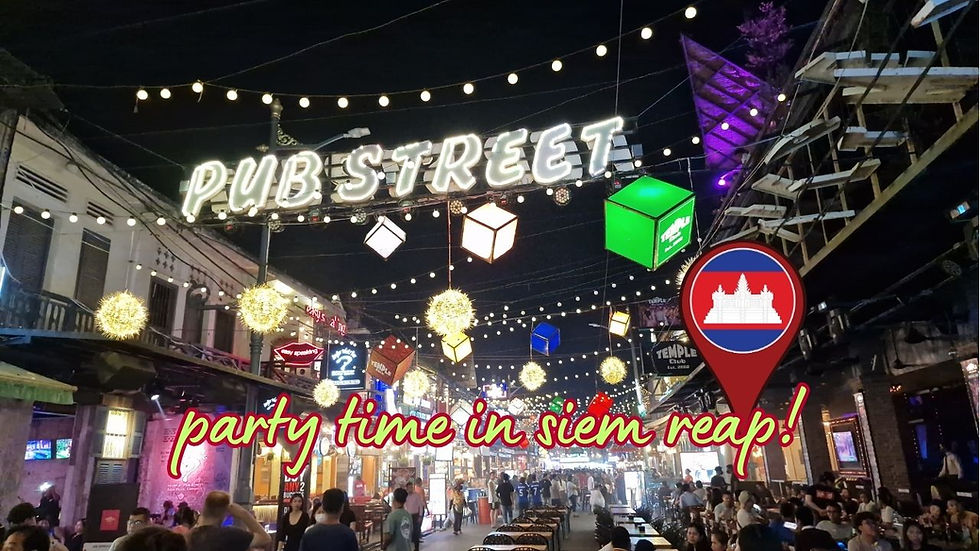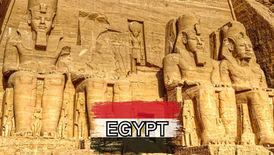Bayon Temple: Towers of Smiles in Angkor, Cambodia
- Jenn & Leon

- Mar 9, 2024
- 12 min read
Updated: 3 days ago
Located in the heart of Angkor Thom, the ancient capital of the Khmer Empire, lies the mesmerizing Bayon Temple, a captivating monument known for its enigmatic smiles.
Built in the late 12th or early 13th century by King Jayavarman VII, it stands as a testament to the king's creative genius and his dedication to Mahayana Buddhism.

The defining feature of Bayon Temple is undoubtedly its 54 towers, each adorned with colossal, enigmatic faces.
These serene smiles, some believe, represent the bodhisattva Avalokiteshvara, the embodiment of compassion in Mahayana Buddhism.
Others suggest they may depict King Jayavarman VII himself, reflecting his perceived divinity as a ruler.
Bayon Temple, along with the other magnificent temples of Angkor in Cambodia, was designated a UNESCO World Heritage Site in 1992.
It is considered one of the most significant archaeological sites in Southeast Asia and continues to captivate visitors with its unique beauty, historical significance, and towers of smiles.
In this post, we show you our highlights, the history of Angkor and the Khmer Empire, interesting facts, how to get there, the best time to visit, and ticket information.

Our Bayon Temple Highlights
Fresh off our visit to Angkor Wat for the sunrise, we then made our way to Bayon, just a short tuk-tuk ride away.
We had caught a glimpse driving past it the previous day and specifically requested our driver to take us there, as we were so intrigued.

You can probably understand why we were curious: 216 faces gazing in all directions from a beautiful collection of lotus towers.
Plus, the empty pillars that stretch across the front of the temple stand tall despite the erosion of the canopy that they once held.

Heading to Bayon Temple at midday was not exactly the brightest of ideas, given the heat was heading north of 40 degrees Celsius (104 Fahrenheit).
Bayon does require some climbing, and although there are some shaded hallways, there is not much by way of blockage from the searing rays of the sun.
Nonetheless, we were keen to make the best of it, even with the thought of dunking in our pool back at our villa rattling around in our minds.
Beyond the captivating faces, the Bayon boasts a wealth of intricate details that offer a glimpse into the Khmer Empire's rich history and artistic mastery.
We were keen to see the incredible 1.2 kilometers of bas-reliefs adorned on the walls depicting scenes from everyday life, religious ceremonies, and even military battles fought by King Jayavarman VII.
These intricate carvings offer a window into the landscape of the Khmer Empire during its peak, and they are indeed everywhere.
Easy to see where they get the kilometers from, that's for sure. There is a lot to see here, and plenty of photo opportunities with the face, too.
Especially Instagram ones!
That being said, this was the first temple that we got a little harassed by 'guides,' borderline desperate to tell us the history and grab our cameras for the 'perfect shot'.
We are fairly experienced with this kind of thing, but here it was particularly difficult to say no. As in, no was not quite enough!
It was a shame, as for the first 20-30 minutes we were here, we weren't left alone. It was okay after that, but we had seen much of what we could, so we decided to head back out.
Bayon Temple is a fascinating one, certainly a standout alongside Angkor Wat in terms of its architectural brilliance and imposing nature.
The faces do get most of the recognition, but preservation is a big factor here, too. It has been remarkably well-restored, and huge credit has to be given for that!
Despite the hawkers making it a bit difficult, we can see why this is one of the most popular temples in Angkor.
Read on for more on the history of Bayon Temple, interesting facts, more about the Khmer Empire, entry information, and some suggestions for other must-see temples nearby.

What Was the Khmer Empire?
The Khmer Empire, which ruled from 802 to 1431 AD, was a powerful Hindu-Buddhist kingdom centered in Southeast Asia, primarily in what is now Cambodia.
They were named after the Khmer people, the dominant ethnic group of the empire.

The Khmer were brilliant hydraulic engineers, constructing a complex network of canals, reservoirs, and moats to manage the mighty Mekong River and its seasonal flooding.
This innovation allowed them to cultivate vast rice fields, fueling a thriving agricultural society.
The Khmer were also master builders. Their most famous achievement is the magnificent Angkor Wat complex, a testament to their architectural prowess and religious devotion.
Throughout their reign, they constructed numerous temples, palaces, and cities, many adorned with intricate carvings depicting their way of life, mythology, and military victories.
The Khmer Empire became a major cultural and political force in Southeast Asia, influencing neighboring kingdoms with their art, architecture, and religious beliefs.
Their legacy lives on not only in the awe-inspiring temples but also in the rich cultural heritage of Cambodia and the region.

The History of Angkor: The Rise of the Khmer Empire
Angkor's history stretches back to the 9th century, marking the rise of the powerful Khmer Empire.
King Jayavarman II declared himself a "universal monarch" in 802, establishing Angkor as the capital and kickstarting a golden age.
The city flourished under successive kings, becoming a center of religion, art, and hydraulic engineering.
Grand temples like Angkor Wat, initially dedicated to Hinduism, were built as testaments to the kings' power and devotion.
Trade thrived, and the empire's territory expanded, reaching its peak in the 12th and 13th centuries.
However, environmental changes, political instability, and conflicts with neighboring kingdoms gradually weakened the empire.
By the 15th century, Angkor was largely abandoned, succumbing to the jungle's embrace.
Though rediscovered in the 19th century, it wasn't until the 20th century that extensive restoration efforts began, revealing the magnificent legacy of the Khmer civilization to the world.
Today, Angkor stands as a UNESCO World Heritage Site, attracting visitors with its captivating temples, intricate carvings, and silent testament to a glorious past.

10 Interesting Facts About Bayon Temple
We have cherry-picked the best facts we could find, but feel free to reach out if you have a gem we could add to the list!
1. Smiling Faces, Enigmatic Origins
The Bayon's iconic feature is its 216 enigmatic faces, each gazing out from 54 towers.
Theories suggest they represent the bodhisattva Avalokiteshvara (compassion) or King Jayavarman VII himself, reflecting his perceived divinity.
2. Everywhere You Look
These faces aren't just friendly; they're omnipresent. Each face gazes in all four directions, symbolizing the Bayon's role as the center of the Buddhist universe in Khmer belief.
3. A Story Carved in Stone
The Bayon isn't just about faces. Over 1.2 kilometers of intricate bas-reliefs adorn the walls, depicting daily life, religious ceremonies, and even King Jayavarman VII's military campaigns, offering a glimpse into the Khmer Empire's past.
4. Lost & Found Name
We don't know what the Khmer people called the temple during its time of use!
The name "Bayon" is a 19th-century French adaptation, possibly derived from the Sanskrit word "paryanika," meaning "pedestal for sacred statues."
5. Royal City, Royal Temple
Unlike Angkor Wat, the Bayon wasn't surrounded by its walls and moats.
Instead, it shared the defensive structures of Angkor Thom, the royal city, highlighting its central role in the kingdom.
6. A King's Legacy
King Jayavarman VII built the Bayon during his reign (1181-1218), likely starting construction late in his life.
The temple's three distinct levels reflect the different phases of construction, each undertaken as the previous one neared completion.
7. More Than Meets the Eye
The Bayon is a multi-level labyrinth. The central tower, originally cruciform, was later modified to create a circular shape, adding to the temple's unique and complex design.
8. Buddhist Transformation
Though built by a Buddhist king, the Bayon may have seen some Hindu influence.
A large Buddha statue once resided in the central sanctuary, but was removed and destroyed during a later Hindu restoration.
9. A Modern Marvel
Despite centuries of weathering and even looting, the Bayon continues to stand tall. Ongoing restoration efforts ensure its preservation for future generations.
10. UNESCO Recognition
The Bayon, along with Angkor Wat and other temples, was designated a UNESCO World Heritage Site in 1992, solidifying its significance as a cultural and historical treasure.

Tips for Visiting the Bayon Temple and the Angkor site
⪢ Start Early
Bayon Temple is amongst the most popular temples in Angkor and can be one of the hottest (depending on the season you visit).
The public areas of the temple are covered in many of the open corridors, but being out in the open is inevitable as you explore.
Try to avoid going during the middle of the day to avoid the peak of the sun.
⪢ Bring Water
It can get hot in the Angkor region, so be sure to bring plenty of water with you and stay hydrated!
⪢ Bring Bug Spray
Mosquitoes are prevalent here, especially during the hot season. If you are prone to bites, bringing repellent can make a big difference.
⪢ Wear Comfortable Shoes
Good footwear is the recommendation here. Most of the floor surfaces are uneven, and there are many steps to ascend and descend.
We understand the love for sandals, but this just does not seem like the right environment for them!
⪢ Dress Appropriately
When visiting Bayon Temple, both men and women should cover their shoulders and knees by avoiding shorts or short skirts. Revealing clothing is not allowed.
It’s a good idea to bring a scarf or shawl for coverage. Access to certain areas may be restricted for those not following these guidelines.
Hats and sunglasses can be worn for sun protection but should be removed when entering the temple.
⪢ Be Aware of Sellers
Angkor attracts over 2 million visitors annually, providing crucial income for locals.
Numerous persistent vendors sell souvenirs, and people at temple sites often offer stories or photography services, expecting payment, though they won't mention it initially.
⪢ Security
The temple security staff are very kind, but also be aware that if they offer to take photos, they are also looking for some cash too!
⪢ Bring Cash
Bring enough cash if you plan to hire a local guide, buy souvenirs, or donate money.
ATMs are scarce and often incompatible with international cards. Most local food stands, stores, and restaurants only accept cash.

Angkor Pass Tickets for Bayon Temple
Bayon Temple is part of the Angkor Archaeological Park; entrance is included with your park ticket.
● 1-day pass: USD 37
● 3-day pass: USD 62 (valid within 10 days)
● 7-day pass: USD 72 (valid within 1 month)
Prices are correct at the time of writing (June 2025).
All prices are in United States dollars. Convert your currency here.

Opening Times & Best Time to Visit the Bayon Temple
⪢ Opening Times
Open daily from 5 am to 6 pm (last entry around 5 pm)
Early arrival is recommended to avoid the midday heat and crowds.
⪢ Best Time to Visit
● Early Morning (5 am – 8 am): Cooler temperatures and fewer tourists. Sunrise visits offer atmospheric lighting on the temple’s famous stone faces.
● Late Afternoon (3 pm – 5:30 pm): Softer light enhances the intricate bas-reliefs and stone carvings; crowds tend to thin later in the day.
● Dry Season (November to February): Ideal weather with pleasant temperatures and minimal rain.
● Avoid: Midday heat (10 am – 3 pm) when the site is busiest and hottest.
💡 Tip: Consider hiring a guide or audio guide to fully appreciate the temple’s rich history and symbolism.

How to Get to Bayon Temple
Bayon Temple is located in the heart of Angkor Thom, just north of the main Angkor Wat complex, within the Angkor Archaeological Park near Siem Reap.
By Tuk-Tuk or Taxi
The most common and convenient way to visit Bayon is by hiring a tuk-tuk or taxi from Siem Reap.
Bayon is approximately 7 km from Siem Reap town center, a 15–20 minute drive depending on traffic.
Tuk-tuk drivers usually offer a full-day or half-day package covering Bayon along with other temples like Angkor Wat, Ta Prohm, and the Terrace of the Elephants.
Typical tuk-tuk rates range from USD 15 - 25 per day, negotiable depending on your itinerary and group size.
By Bicycle
Adventurous visitors can cycle to Bayon Temple.
From Siem Reap town center, it’s about a 7 km ride on mostly flat roads with some traffic.
Bring water, sunscreen, and a map or GPS for navigation.
By Tour Bus or Group Tour
Many organized tours from Siem Reap include the Bayon Temple on their itinerary.
Group buses or vans pick you up from your hotel and provide transport and a guide for the day.
GetYourGuide Tour Option
For a hassle-free experience with skip-the-line access and expert guides, consider booking an Angkor tour via GetYourGuide. These tours often include:
● Hotel pickup and drop-off from Siem Reap
● Entry fees included
● Guided exploration of Angkor and its temples
● Small group sizes for a personalized experience
🎟️ Book your Angkor Tour on GetYourGuide
Car Rental
Whether you're planning scenic road trips or quick rides around town, renting a car or scooter can save time. Rentalcars.com helps you find the best deals from reputable providers.

Where to Stay Near Bayon Temple
Looking for a place to stay nearby? Browse Siem Reap hotel deals below to find great rates from top providers in the city.
Our map offers a user-friendly interface that allows you to zoom in and out, providing a comprehensive view of the area and enabling you to identify the most convenient hotel options based on your current location or desired destination.

Other Must-See Temples Near Bayon

Angkor Wat
Temple
Just south of Bayon, Angkor Wat is the world’s largest religious monument and Cambodia’s most famous temple. Its iconic five-towered silhouette is a must-see.

Terrace of the
Elephants
Located just east of Bayon, this terrace was used as a viewing stand for ceremonies. Admire the detailed elephant carvings and scale of this impressive platform.

Ta Prohm
Famed for the way large trees have intertwined with the ruins, the film "Lara Croft: Tomb Raider" brought global attention to Ta Prohm.

Phimeanakas
Situated inside Angkor Thom near Bayon, Phimeanakas is a Hindu temple shaped like a three-tiered pyramid. It is quieter and less crowded.
Watch the Angkor Sunrise on YouTube
Angkor Wat is indeed a bucket list destination for many people, being the largest spiritual complex on earth!
In this video, we share with you some of our incredible sunrise footage from Angkor, along with some tips on how to make your morning and day go a little smoother.
We also show you where to pick up your temple day (or week) pass (you must be present as they take a photo and give you a tangible card).
If you enjoy our video and want to follow more of our adventures, please like and subscribe!
Your support truly is invaluable to us, and we will always strive to produce the best content we can from around the world.
Our Experience Rating:
Bayon Temple

Bayon Temple is a fascinating one, certainly a standout alongside Angkor Wat in terms of its architectural brilliance and imposing nature.
The faces do get most of the recognition, but preservation is a big factor here, too. It has been remarkably well-restored, and huge credit has to be given for that!
There are many temples to see at Angkor, and they all have their individual brilliance, but we would say this one should be high up on the list.
They certainly do not all have over 200 faces on towers!
FAQ: Bayon Temple – What to Know Before You Visit
What is Bayon Temple famous for?
Bayon is renowned for its enigmatic stone faces — over 200 serene, smiling visages believed to represent King Jayavarman VII or Avalokiteshvara, the Bodhisattva of Compassion.
Where is it located?
Bayon sits at the exact center of Angkor Thom, the ancient capital of the Khmer Empire. It’s about 1.5 km north of Angkor Wat and is often included in the Small Circuit Tour of temples.
Do I need a ticket to enter Bayon?
Yes. Entry is included with the Angkor Pass, which also covers Angkor Wat, Ta Prohm, and dozens of other temples.
● 1-day pass: USD 37
● 3-day pass: USD 62 (valid within 10 days)
● 7-day pass: USD 72 (valid within 1 month)
What are the opening hours?
Bayon Temple is open daily from 5 am to 6 pm. It’s best visited in the morning when lighting enhances the carvings, or late afternoon to avoid midday heat.
How long should I spend there?
Allow 45 minutes to 1.5 hours to wander through the three levels, admire the faces up close, and study the intricate bas-reliefs depicting battles, mythology, and daily Khmer life.
Is there a best time of day to visit for photos?
Yes! Early morning (before 9 am) or golden hour around 4 pm provides the most flattering light on the faces and less crowding.
💡 Bring a zoom lens or a wide-angle lens if you’re into photography.
How challenging is it to explore?
The structure has some steep steps and uneven stones, especially at the top level. Sturdy footwear is recommended. It’s moderately challenging compared to other temples.
Can you climb the central towers?
Yes, the upper terrace is open to the public, allowing close-up views of the giant faces and panoramic shots of the temple’s complex layout.
Note that access is sometimes restricted or closed without warning.
Is Bayon Buddhist or Hindu?
Bayon was built as a Mahayana Buddhist temple by King Jayavarman VII, but later Hindu kings modified some of its features, resulting in a blend of religious iconography.
Are guides available?
Yes, local guides at the site or tour packages from Siem Reap can offer fascinating context about the symbolism, architecture, and historical timeline of the temple.








































































































There are many fascinating temples at Angkor, but in my opinion, none more so than Bayon, with its 200+ carved stone faces gazing out across Angkor Thom. It should be high up on the list, perhaps even top 5. Just saying.